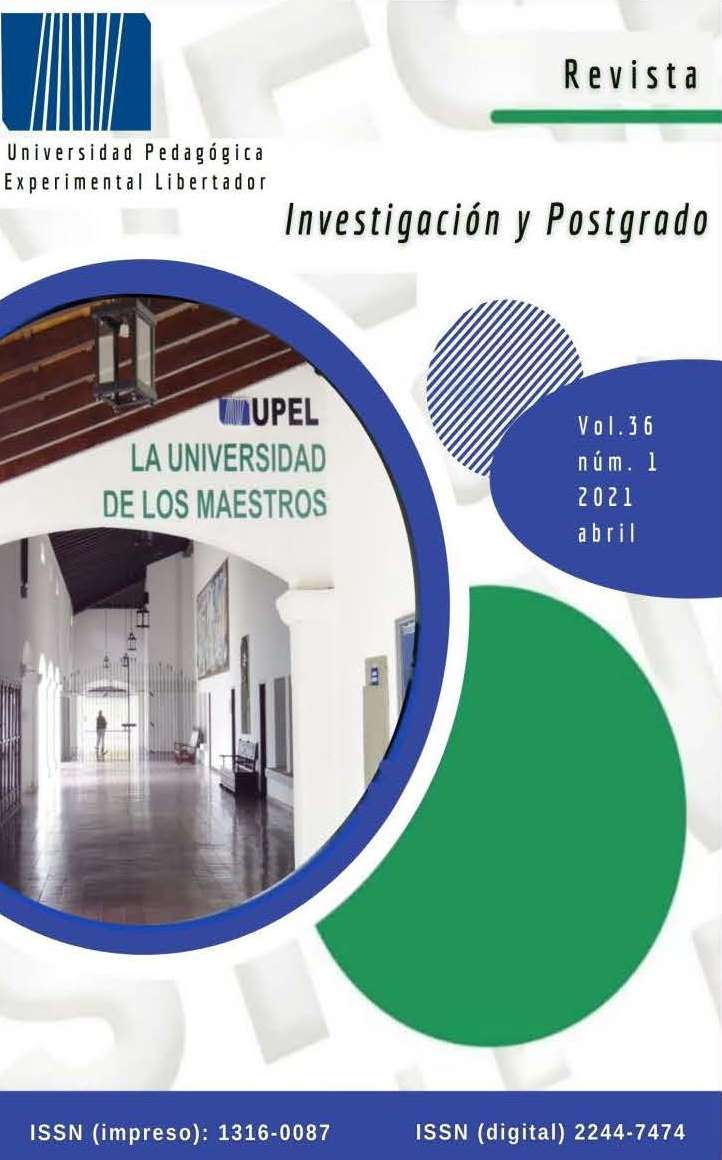THE DEPENDENCE OF THE SOCIAL NETWORKS IN PERUVIAN UNIVERSITY STUDENTS DURING COVID-19
DOI:
https://doi.org/10.56219/investigacinypostgrado.v36i1.2769Keywords:
social networks, university students, communication and information technologies, COVID-19Abstract
The aim of the study was to determine the dependence of Peruvian university students on social networks during the COVID-19 pandemic. The design was cross-sectional. The sample consisted of 96 students from a public university, who voluntarily participated in an online survey, consisting of 24 items, with 5 Likert-type ratings, whose Alpha was 0.955. It was concluded that 91.7% of the participants showed that they were using the Internet daily for different purposes, but with greater regularity to
check the social networks, especially Facebook with 79.2%. In addition, it was established that the correlation is significant in the 0.01 bilateral level, which indicates that the three factors into the items were grouped when performing the analysis (obsession with social networks, lack of control and excessive use) correlated significantly, thus determining the level of dependence on that social network.
Downloads
References
Andreassen, C. (2015). Online social network site addiction: A comprehensive review. Current Addiction Reports, 2, 175-184.
Appignani, T., Jones, S., Watson, M. y Welch, E. (2015). Social media in the workplace. The 16 th Annual Meeting of the Association of Internet Researchers. Phoenix, AZ, USA/ 21-24. Octuber 2015.
Bold, M. y Ellison, N. (2007). Social Network Sites: definition, history and scholarship. Journal of Computer-Mediated Communication. Disponible en http://itqro.com/moodledata/30/Apuntes_de_apoyo_en_clase/Redes_Sociales_2.pdf
Cohen, J. (1988). Statistical power analysis for the behavioral sciences. Lawrence Earlbaum Associates.
Domínguez, J. y Ybañez, J. (2016). Addiction to Social Networks and Social Skills in Students from a Private Educational Institution. Propósitos y Representaciones, 4(2), 207-230. doi:10.20511/pyr2016.v4n2.122
Escurra, M. y Salas, E. (2014). Construcción y validación del cuestionario de adicción a redes sociales (ARS). Liberabit, 20(1), 73-91.
García, J. (2013). Adicciones tecnológicas: el auge de las redes sociales. Salud y Drogas, 13, 5-14.
Gibson, C., Hardy, J. y Buckley, M. (2014). Understanding the role of net-working in organizations. Career Development International, 19(2), 146-161.
Hernández, R., Fernández, C. y Baptista, P. (2014). Metodología de la investigación. McGraw-Hill Interamericana Editores.
Igarza, R. (2009). Burbujas de ocio: Nuevas formas de consumo cultural. La Crujía.
Jiménez, S. y Farré, J. (2015). Adicción a las nuevas tecnologías: ¿La epidemia del S. XXI? Editorial Siglantana.
Naveenraj, X. y Reeves, W. (2017). Social networking sites in the workplace: an imperative. Desarrollo y aprendizaje en las organizaciones, una revista internacional, 31(3). 4-6.
Oliva, A., Hidalgo, M., Moreno, C., Jiménez, L., Jiménez, A., Antolín, L. y Ramos, P. (2012). Uso y riesgo de adicciones a las nuevas tecnologías entre los adolescentes y jóvenes Andaluces. España: Agua Clara, SL. Recuperado de https://personal.us.es/oliva/libroadicciones.pdf
Prieto, J. y Moreno, A. (2015). Las redes sociales de internet ¿una nueva adicción? Revista Argentina de Clínica Psicológica, 24(2), 149-155.
Rodríguez, L., Madero, S. y Valerio G. (2018). Perceptions about the usefulness of online social networks in the workplace. Estudios Gerenciales. Journal of management and economic for Iberoamerica, 34(14a), 149-157. https://doi.org/10.18046/j.estger.2018.147.2580
Sahagún, M., Martínez, B., Delgado, E. y Salamanca-Rodríguez, C.G. (2015). Adicción a redes sociales y su relación con problemas de autoestima en la población de 15 a 19 años en población derechohabiente del Instituto Mexicano del Seguro Social. Revista Médica MD, 6(4), 286-289.
Volkom, M., Stapley, J. y Amaturo V. (2014). Revisiting the Digital Divide: Generational Differences in Technology use in everyday life. North American Journal of Psychology, 16(3), 557-574.
Published
How to Cite
Issue
Section
License
Copyright (c) 2024 Universidad Pedagógica Experimental Libertador

This work is licensed under a Creative Commons Attribution-NonCommercial-ShareAlike 4.0 International License.
Investigación y Postgrado está bajo una licencia internacional Creative Commons Attribution-NonCommercial-ShareAlike 4.0 .
La política de acceso abierto y de licencias con “algunos derechos reservados” no niega la propiedad intelectual ni los derechos de los autores respecto a sus artículos, al contrario, los respeta. Es por ello que:
No se reservan los derechos de publicación de los artículos. Los autores podrán distribuir su artículo en cualquier otro medio, siempre y cuando sea sin fines de lucro. Debe informar al Editor de esta nueva publicación y debe dar el crédito a la revista Investigación y Postgrado.













